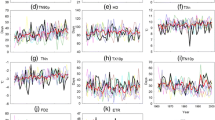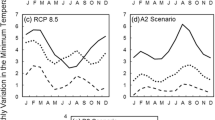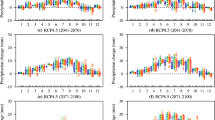Abstract
This study aims to evaluate the performance of two mainstream downscaling techniques: statistical and dynamical downscaling and to compare the differences in their projection of future climate change and the resultant impact on wheat crop yields for three locations across New South Wales, Australia. Bureau of Meteorology statistically- and CSIRO dynamically-downscaled climate, derived or driven by the CSIRO Mk 3.5 coupled general circulation model, were firstly evaluated against observed climate data for the period 1980–1999. Future climate projections derived from the two downscaling approaches for the period centred on 2055 were then compared. A stochastic weather generator, LARS-WG, was used in this study to derive monthly climate changes and to construct climate change scenarios. The Agricultural Production System sIMulator-Wheat model was then combined with the constructed climate change scenarios to quantify the impact of climate change on wheat grain yield. Statistical results show that (1) in terms of reproducing the past climate, statistical downscaling performed better over dynamical downscaling in most of the cases including climate variables, their mean, variance and distribution, and study locations, (2) there is significant difference between the two downscaling techniques in projected future climate change except the mean value of rainfall across the three locations for most of the months; and (3) there is significant difference in projected wheat grain yields between the two downscaling techniques at two of the three locations.




Similar content being viewed by others
References
Baron C, Sultan B, Balme M, Sarr B, Traore S, Lebel T, Janicot S, Dingkuhn M (2005) From GCM grid cell to agricultural plot: scale issues affecting modelling of climate impact. Philos Trans R Soc B 360(1463):2095–2108
Baigorrial GA, Jones JW, Shin DW, Mishra A, O’Brien JJ (2007) Assessing uncertainties in crop model simulations using daily bias-corrected Regional Circulation Model outputs. Clim Res 34:211–222
Charles SP, Bates B, Viney N (2003) Linking atmospheric circulation to daily rainfall patterns across the Murrumbidgee River Basin. Water Sci Technol 48(7):233–240
Ewert F, Rodriguez D, Jamieson P, Semenov MA, Mitchell RAC, Goudriaan J, Porter JR, Kimball BA, Pinter PJ Jr, Manderscheid R, Weigel HJ, Fangmeier A, Fereres E, Villalobos F (2002) Effects of elevated CO2 and drought on wheat: testing crop simulation models for different experimental and climatic conditions. Agric Ecosyst Environ 93:249–266
Frost AJ, Charles SP, Mehrotra R, Timbal B, Nguyen KC, Chiew FHS, Fu G, Chandler RE, McGregor J, Kirono DGC, Fernandez E, Kent D (2011) A comparison of multi-site daily rainfall downscaling techniques under Australian conditions. J Hydrol 408(1–2):1–18
Hay LE, Wilby RL, Leavesley GH (2000) A comparison of delta change and downscaled GCM scenarios for three Mountainous basins in the United States. J Am Water Resour Assoc 36(2):387–397
Ines AVM, Hansen JW (2006) Bias correction of daily GCM rainfall for crop simulation studies. Agric For Meteorol 138:44–53
Leung RL, Mearns LO, Giorgi F, Wilby RL (2003) Regional climate research: needs and opportunities. Bull Am Meteorol Soc 84:89–95
Luo Q, Williams MAJ, Bellotti W, Bryan B (2003) Quantitative and visual assessment of climate change impacts on South Australian wheat production. Agric Syst 77:173–186
Luo Q, Bellotti WD, Williams M, Bryan B (2005a) Potential impact of climate change on wheat yield in South Australia. Agric For Meteorol 132(3–4):273–285
Luo Q, Jones R, Williams M, Bryan B, Bellotti WD (2005b) Construction of probabilistic distributions of regional climate change and their application in the risk analysis of wheat production. Clim Res 29(1):41–52
Luo Q, Bellotti WD, Williams M, Jones R (2006) Probabilistic analysis of potential impacts of climate change on wheat production in contrasting environments of South Australia. World Resour Rev 17(4):517–534
Luo Q, Bellotti WD, Williams M, Wang E (2009) Adaptation of wheat growing in south Australia to climate change: analysis of management and breeding strategies. Agric Ecosyst Environ 129:261–267
Luo Q, Bellotti WD, Hayman P, Williams M, Devoil P (2010) Effects of changes in climatic variability on agricultural production. Clim Res 42:111–117
Luo Q, Yu Q (2012) Developing higher resolution climate change scenarios for agricultural risk assessment: progress, challenges and prospects. Int J Biometeorol 56(4):557–568
Luo Q, Kathuria A (2013) Modelling the response of wheat grain yield to climate change: a sensitivity analysis. Theor Appl Climatol 111(1–2):173–182
Macadam I, Pitman AJ, Whetton PH, Abramowitz G (2010) Ranking climate models by performance using actual values and anomalies: implications for climate change impact assessments. Geophys Res Lett 37:L16704. doi:10.1029/2010GL043877
McGregor JL (1997) Regional climate modelling. Meteorog Atmos Phys 63(1-2):105–117
McGregor JL, Dix MR (2008) An updated description of the Conformal-Cubic Atmospheric Model. In: Hamilton K, Ohfuchi W (ed) High resolution simulation of the atmosphere and ocean. Springer, New York, pp 51–76
Mearns LO, Easterling W, Hays C, Marx D (2001) Comparison of agricultural impacts of climate change calculated from high and low resolution climate model scenarios: Part I. The uncertainty ue to spatial scale. Clim Chang 51:131–172
Mearns LO, Carbone G, Tsvetsinskaya E, Adams R, McCarl B, Doherty R (2003) The uncertainty of spatial scale of climate scenarios in integrated assessments: an example from agriculture. Integr Assess 4(4):225–235
Mitchell TD (2003) Pattern scaling: an examination of the accuracy of the technique for describing future climates. Clim Chang 60:217–242
Oettli P, Sultan B, Baron C, Vrac M (2011) Are regional climate models relevant for crop yield prediction in West Africa? Environ Res Lett 6:014008. doi:10.1088/1748-9326/6/1/014008
Probert ME, Dimes JP, Keating BA, Dalal RC, Strong WM (1998) APSIM’s water and nitrogen modules and simulation of the dynamics of water and nitrogen in fallow systems. Agric Syst 56:1–28
Qian BD, Gameda S, Hayhoe H, De Jong R, Bootsma A (2004) Comparison of LARS-WG and AAFC-WG stochastic weather generators for diverse Canadian climates. Clim Res 26(3):175–191
Qian BD, Hayhoe H, Gameda S (2005) Evaluation of the stochastic weather generators LARS-WG and AAFC-WG for climate Change Impact studies. Clim Res 29(1):3–21
R Development Core Team (2011) R: A language and environment for statistical computing, reference index version 2.13.0. R Foundation for Statistical Computing, Vienna, Austria. ISBN 3-900051-07-0, url: http://www.R-project.org
Reilly J, Stone PH, Forest CE, Webster MD, Jacoby HD, Prinn RG (2001) Uncertainty and climate change assessment. Science 293:430–433
Rosenzweig C, Jones JW, Hatfield JL, Ruane AC, Boote KJ, Thorburn P, Antle JM, Nelson GC, Porter C, Janssen S, Asseng S, Basso B, Ewert F, Wallach D, Baigorria G, Winter JM (2013) The Agricultural Model Intercomparison and Improvement Project (AgMIP): protocols and pilot studies. Agric For Meteorol 170:166–182, http://dx.doi.org/10.1016/j.agrformet.2012.09.011
Rötter RP, Carter TR, Olesen JE, Porter JR (2011) Crop-climate models need overhaul. Nat Clim Chang 1:175–177
Semenov MA, Brooks RJ, Barrow EM, Richardson CW (1998) Comparison of the WGEN and LARS-WG stochastic weather generators in diverse climates. Clim Res 10:95–107
Semenov MA (2008) Simulation of extreme weather events by a stochastic weather generator. Clim Res 35:203–212
Semenov MA, Stratonovitch P (2010) The use of multi-model ensembles from global climate models for impact assessments of climate change. Clim Res 41:1–14
Stott PA, Kettleborough JA (2002) Origins and estimates of uncertainty in predictions of twenty-first century temperature rise. Nature 416:723–726
Timbal B, Fernandez E, Li Z (2008) Generalization of a statistical downscaling model to provide local climate change projections for Australia. Environ Model Softw 24:341–358
Wang Y, Leung LR, McGregor JL, Lee D-K, Wang W-C, Ding Y, Kimura F (2004) Regional climate modeling: progress, challenges, and prospects. J Meteorol Soc Jpn 82:1599–1628
Webster M, Sokolov A (1998) Quantifying the uncertainty in climate predictions. Program report on the Science and Policy of Global Change. Massachusetts Institute of Technology
White JW, Hoogenboom G, Kimball B, Wall GW (2011) Methodologies for simulating impacts of climate change on crop production. Field Crops Res 124:357–368
Wolf J, Evans LG, Semenov MA, Eckersten H, Iglesias A (1996) Comparison of wheat simulation models under climate change. I. Model calibration and sensitivity analyses. Clim Res 7:253–270
Zhang H, Henderson-Sellers A, Pitman AJ, Desborough CE, McGregor JL, Katzfey JJ (2001) Limited-area model sensitivity to the complexity of representation of the land surface energy balance. J Clim 14:3965–3986
Zorita E, Von Storch H (1999) The analog method - a simple statistical downscaling technique: comparison with more complicated methods. J Climate 12:2474–2489
Acknowledgments
Funding for the CCAM simulations was provided by the South East Australian Climate Initiative. We thank staff of CMAR for providing output from the Mk 3.5 GCM simulations, Dr Kim Nguyen for extracting the CCAM output and Dr M.A. Semenov, Rothamsted Research, UK, for providing the LARS-WG model.
Author information
Authors and Affiliations
Corresponding author
Electronic supplementary material
Below is the link to the electronic supplementary material.
Online Resource 1
(DOCX 26 kb)
Online Resource 2
(DOCX 13 kb)
Online Resource 3
(DOCX 267 kb)
Rights and permissions
About this article
Cite this article
Luo, Q., Wen, L., McGregor, J.L. et al. A comparison of downscaling techniques in the projection of local climate change and wheat yields. Climatic Change 120, 249–261 (2013). https://doi.org/10.1007/s10584-013-0802-8
Received:
Accepted:
Published:
Issue Date:
DOI: https://doi.org/10.1007/s10584-013-0802-8




